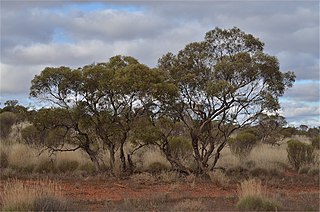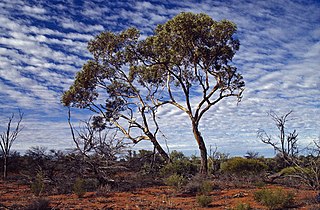
Eucalyptus erythronema, commonly known as the red-flowered mallee, is a species of mallee or tree and is endemic to Western Australia. It has smooth, dark pink to red bark that is shed to reveal whitish bark, and has lance-shaped adult leaves, pendulous flower buds mostly arranged in groups of three, red or yellow flowers and conical fruit.

Eucalyptus lansdowneana, commonly known as the crimson mallee or the red-flowered mallee box, is a species of slender stemmed, straggly mallee that is endemic to a restricted area of South Australia. It has rough, fibrous or flaky bark at the base, smooth, grey over creamy-white bark, lance-shaped adult leaves, flower buds in groups of seven, crimson flowers and barrel-shaped fruit.

Eucalyptus flocktoniae, commonly known as merrit, is a species of tree or mallee that is endemic to Western Australia. It has smooth, silvery grey bark, lance-shaped to curved adult leaves, prominently beaked flower buds in groups of seven or nine and barrel-shaped or urn-shaped fruit.

Eucalyptus socialis, commonly known as the red mallee, or grey mallee, is a species of mallee that is endemic to inland Australia.

Eucalyptus calycogona, commonly known as the gooseberry mallee or square fruited mallee, is a mallee that is endemic to southern Australia. It has smooth bark, narrow lance-shaped adult leaves, flower buds that are square in cross-section arranged in groups of seven in leaf axils, creamy white, sometimes pink flowers, and fruit that are square in cross-section.

Eucalyptus effusa, commonly known as rough-barked gimlet, is a species of mallee or small tree that is endemic to Western Australia. It has thin, rough bark on the base of the trunk, smooth bark above, linear to narrow lance-shaped adult leaves, flower buds arranged in groups of seven, white flowers and cup-shaped to conical fruit.

Eucalyptus mannensis, commonly known as Mann Range mallee, is a species of mallee that is native to Western Australia, South Australian and the Northern Territory. It has rough bark at the base of the trunk, smooth bark above, narrow lance-shaped adult leaves, flower buds in groups of between seven and eleven, creamy white flowers and hemispherical fruit.

Eucalyptus rugosa, commonly known as the Kingscote mallee, is a species of mallee that is endemic to coastal areas of southern Western Australia and South Australia. It has smooth bark, lance-shaped adult leaves, flower buds in groups of between seven and thirteen, white flowers and cup-shaped, conical or hemispherical fruit.

Eucalyptus striaticalyx, commonly known as Cue York gum or kopi gum, is a species of tree or mallee that is endemic to Western Australia. It has thick, rough, fibrous bark on the trunk and larger branches, lance-shaped adult leaves, flower buds in groups of between seven and thirteen, creamy white flowers and conical to cup-shaped fruit.
Eucalyptus vegrandis, commonly known as the Ongerup mallee or Cranbrook mallee, is a species of mallee that is endemic to the south-west of Western Australia. It has smooth bark, linear to lance-shaped adult leaves, flower buds in groups of seven, creamy white flowers and cup-shaped or conical fruit.

Eucalyptus wimmerensis, commonly known as the Wimmera mallee box or the broad-leaved green mallee, is a species of mallee that is endemic to an area around the border between Victoria and South Australia. It usually has smooth bark on the trunk and branches, linear to narrow oblong leaves, flower buds in groups of seven to eleven, white flowers and cup-shaped to barrel-shaped fruit.

Eucalyptus falciformis, commonly known as the Grampians peppermint or western peppermint, is a species of tree or mallee that is endemic to south eastern Australia. It has smooth bark, sometimes with rough, fibrous bark at the base, narrow lance-shaped to egg-shaped or curved adult leaves, flower buds in groups of eleven to twenty one, white flowers and cup-shaped to shortly cylindrical fruit.

Eucalyptus arcana, commonly known as the Mallee manna gum or Carpenter Rocks gum is a mallee that is endemic to South Australia. It has rough bark from the base of the trunk to the thinnest branches, lance-shaped, sometimes curved leaves, flower buds in groups of seven, white flowers and hemispherical fruit. It is only known from a single population near Carpenter Rocks.

Eucalyptus conglobata, also known as the cong mallee or Port Lincoln mallee, is a species of eucalypt that is native to the south coast of Western Australia and South Australia. It is a mallee with smooth bark, lance-shaped adult leaves, flower buds in groups of seven, white flowers and clustered hemispherical fruit.

Eucalyptus alatissima is a mallee that is endemic to central parts of the Great Victoria Desert. It has rough bark on the lower part of its stems, smooth tan to cream-coloured bark on its upper parts, egg-shaped to lance-shaped leaves and buds in groups of three. The buds have a powdery covering and are prominently winged.

Eucalyptus canescens, commonly known as the Ooldea Range mallee or Beadell's mallee, depending on subspecies, is a species of mallee that is endemic to southern Australia. It has rough bark from the base of the trunk to the thicker branches, smooth bark on the thin branches, egg-shaped to lance-shaped adult leaves, flower buds in groups of between seven and eleven, creamy white flowers and smooth cup-shaped to conical, and sometimes ribbed fruit.

Eucalyptus socialis subsp. eucentrica, commonly known as the inland red mallee, is a subspecies of mallee that is endemic to inland Australia. It usually has rough bark on the base of the trunk, smooth bark above, lance-shaped adult leaves, flower buds in groups of between seven and eleven, pale creamy yellow flowers and barrel-shaped to urn-shaped or spherical fruit.

Eucalyptus socialis subsp. socialis, commonly known as the summer red mallee, is a subspecies of mallee that is endemic to inland south-eastern Australia. It usually has rough bark on the base of the trunk, smooth bark above, lance-shaped adult leaves, flower buds in groups of between seven and eleven, pale creamy white flowers and barrel-shaped to urn-shaped or spherical fruit.

Eucalyptus socialis subsp. victoriensis, commonly known as the red mallee, is a subspecies of mallee that is endemic to southern inland Australia. It usually has rough bark on the base of the trunk, smooth bark above, lance-shaped adult leaves, flower buds in groups of between seven and eleven, pale creamy yellow flowers and barrel-shaped to urn-shaped or spherical fruit.
Eucalyptus socialis subsp. viridans, commonly known as the green-leaved red mallee, is a subspecies of mallee that is endemic to south-eastern Australia. It usually has rough bark on the base of the trunk, smooth bark above, lance-shaped adult leaves, flower buds in groups of between seven and eleven, pale creamy yellow flowers and barrel-shaped to urn-shaped or spherical fruit.




















